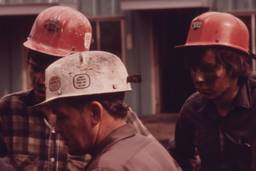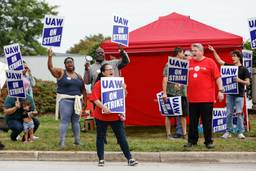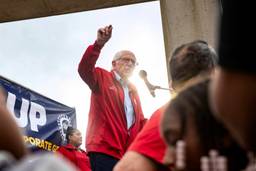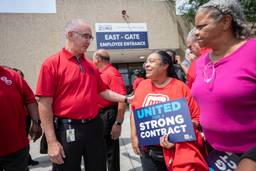How the Labor and Environmentalist Movements Can Put Workers at the Center of Climate Justice
Trish Kahle
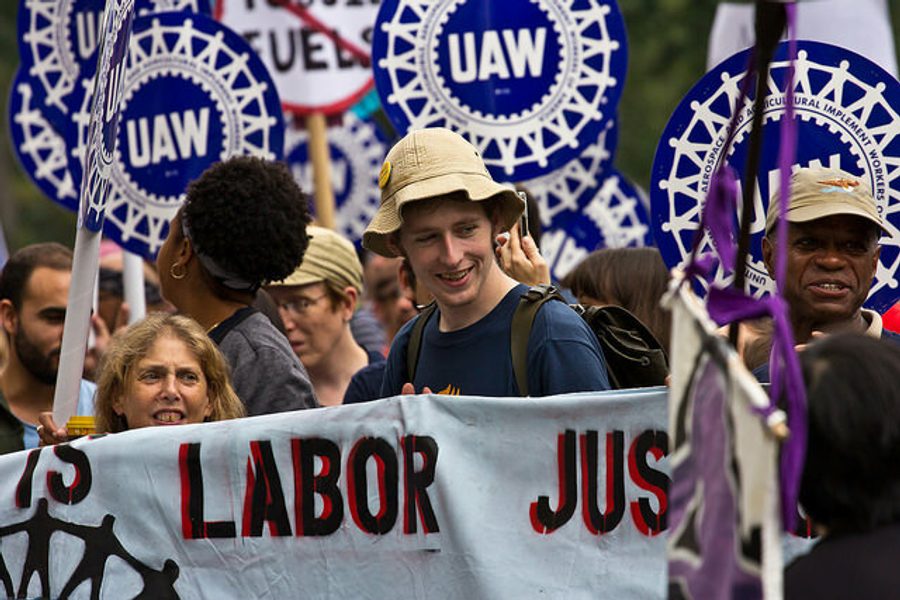
2015, only halfway over, has already been an extreme year for both labor and the climate: the Midwest and Texas are experiencing record rainfall while California is in a record-breaking drought, and 2015 is the hottest year on record so far (the standing record is from 2014), including a heatwave in India that left more than 2,300 people dead. The Obama administration continues to try and push through the Trans-Pacific Partnership on fast-track, with millions of workers livelihoods hanging in the global balance and attacks on unions like the United Steelworkers continue to threaten worker, community and environmental safety. Meanwhile, energy companies insist that drilling in the soon-to-be ice-free summertime arctic will create jobs — even as it may mean game over for the climate.
There has perhaps never been a more prescient moment to emphasize what a growing number of people already know: the fate of labor and the climate are linked. In his most recent piece for The Nation, Jeremy Brecher notes how well suited the traditions of the labor movement are to the fight for climate protection: “The labor movement’s most essential value is solidarity … that we will survive and prosper only if we look out for one another. Climate protection is the new solidarity.” Brecher, a founder of the Labor Network for Sustainability and author of Climate Insurgency: A Strategy for Survival as well as the classic labor history Strike! is at the forefront of the struggle to break down the false dichotomy of “jobs versus environment” and to fight for a just transition that puts workers at the center of a vision of climate justice.
In These Times recently spoke with Brecher to consider this central question: How do we fight for a just transition that puts workers at the center of a vision of climate justice?
What compelled you to write your latest article in The Nation?
I felt like those who observed the big impact of labor participation in the People’s Climate March didn’t have any way to find out about all the things that happened afterwards. The motivation for the article was to share that experience of what was going on, talking to the people who were doing those kinds of activities and to try to put it in some kind of context in which people could relate it to the overall strategy of bringing labor to the forefront of the climate movement.
The role of labor in the climate justice movement is a really broad and varied one, and workers and activists are starting to make connections. Some of these connections, like the one between the struggle of railroaders for safer working conditions and communities concerned about oil spills from derailing trains, are clear, but what links between the labor and environmentalist movements do you see that might be less than obvious?
Links are never obvious until someone makes the link. Take the plumbers’ and pipefitters’ unions: a few years ago, they declared themselves green building trades unions. They developed a training and certification program for green builders and sent a trailer truck around the country promoting their role in making buildings energy efficient. Because they reached out, they made the link between the work that they do and climate protection.
I did a workshop with machinists’ union workers in Windsor Locks, Connecticut, and we started talking about what they could do as workers — not only fighting for good climate policies but actually changing the kind of work they do. They started saying, “We make gauges and valves and all kinds of things that are necessary for running low-waste water systems and all kinds of infrastructure.” They made suggestions about how they could be used to fight climate change.
In Connecticut, we have a roundtable on the climate and jobs which tries to draw together trade unionists and other people who are concerned about the climate, including religious groups. We just got a new governor’s council on climate change which is working on a new climate action plan. It’s hard to keep up with the people asking how they can help out with this work as shown by all the things that have happened without any large scale organization in the wake of the People’s Climate march.
If we build a movement, we can accomplish things in our unions and industries regardless of what’s happening in Washington. There is power that doesn’t come from Congress, and we are the ones who can impose it. That certainly doesn’t mean that we don’t have to change the national political framework and the global political framework to address climate change. We can start building the building blocks even if we don’t have immediate access to the commanding heights of power.
And yet the question of political power seems paramount, not something we can just hope will work itself out. What are we actually doing now in terms of building a political alternative that has at its heart both the interests of working people and the environment?
The core starting point for me is to find a program that unites climate change and jobs and worker-friendly developments. That is a program the 99% can be organized around. Partially by doing local and national plans for worker-friendly, good job-producing climate protection strategies, and partially by drawing together the constituencies that have the strongest stake in doing that.
Linking environmentalism to higher standards of living for the working class is key. It’s far too easy for arguments for “degrowth” to be marshalled in the name of austerity. How can activists make clear that when we challenge the narrative of growth, we’re actually aiming at the elites, the corporations, and not at working people?
Both the labor movement and the environmental movement, and the world they’re embedded in, have gotten off on the wrong foot in relation to the word “growth.” If you’re saying we need less growth of bombs and pollution and poisons, then the people who say we need less growth are totally on the right track. If you say we need more growth of healthy food, good medical care, good housing for people in bombed-out areas of cities like Chicago — those people are also totally on the right track. The question of growth is confused because growth is often expressed in terms of GDP.
Efforts to reduce carbon emissions will create far more jobs than the fossil fuel industry has or could. Climate protection is far more job-intensive than carbon-based energy. The problem with that is that the jobs that are going to be lost are held by very specific people who live in very specific places and have very specific skills.
We need a general jobs program, but we also need to have time for a just transition. People have been advocating this for decades. Tony Mazzocchi, the former president of the Oil, Chemical and Atomic Workers Union, was one of the original inspirers of this way of thinking. He had a plan for a Superfund for workers. And there has actually been for the first time a significant initiative, just in the last few months, for the Power+ Plan. The most recent Obama administration budget has set aside $55 million for a program very much along the lines of the one called for by my organization, Labor Network for Sustainability. Many others have been advocating for a just transition for fossil fuel workers. They have proposals for big land reclamation activities which will employ and provide training for a lot of people and begin expanding environmental tourism and environmental, sustainable farming economy and so on. We’ve been pushing the Obama administration to do this for years; its time has finally come.
The missing piece that has to be added to a general jobs program is a just transition program to make sure that people who will be adversely affected by climate protection will not be made the butt of this program.
The companies that are in the business of destroying the atmosphere by making money off of fossil fuels have as their strongest suit money to use for ideological warfare, but coal miners are well respected culturally in the labor movement. They were at the forefront of some of the country’s most militant labor struggles. Therefore, coal companies have spent vast amounts of money making the ideological framework of climate protection all about destroying the jobs of coal miners.
A just transition will be a massive undertaking. Who should pay? Could a demand that companies who have destroyed the environment should be made to pay for job training and land reclamation be put forward?
I saw recently a proposal for putting a royalty on coal extraction to support the health and safety plan or to support various kinds of land reclamation programs. This was a similar kind of program I saw for coal miners and other coal-related workers. Something in the budget for a just transition program would be great, too. There’s no reason that various sources should not have been contributing to these workers and families who have been sacrifice zones not only for decades but also for a couple of centuries.
Will the shifts to renewable energy help us do away with sacrifice zones?
Definitely. Anything that human beings do, there are potential risks. Solar panels make some pollution. Production of green energy equipment is energy intensive. You can’t change everything instantly.
We need to be aware that the record of nationalized, publicly owned energy industries is not stellar, either on pollution issues, on greenhouse gas emission issues or on worker health and safety. We need to have a planned transition to a climate-safe country and world; that involves more social control and less freedom for corporations to do whatever they want to do to make the biggest buck. I don’t think we need to, say, immediately nationalize the energy industry — that could be a last rather than a first step.
There have been periods where there were great hopes for solar installations to expand, or energy efficiency of buildings to increase greatly. Large numbers of people were trained and then there were no jobs for the people who were trained. Then a few years later, there’s a real expansion of rooftop solar — we are having one in Connecticut, because it’s so much cheaper than it was just a few years ago. The governor wants to increase the amount of rooftop solar by tenfold. Already they have a labor shortage. It’s going to happen over and over again. From the labor side of it and other aspects, you need a much more planned, organized way to make that transition.
A “planned transition” — is that coming from the Federal or state level?
That question is only beginning to be opened up. What I’m working on in my state is working to see that a climate action plan that’s being developed has a strategy for that kind of planning. We’ve got the state officials who are dealing with solar energy expansion facing this labor shortage. I hope that they’re seeing that they must make a planned program.
How do we take up the question of planned economies and nationalization in the current political climate?
Again, I think we have to start where we can. Because we have a context where we have labor support and a governor and a legislature that are concerned, I’m working at the state level for one thing to try to get them to think of the necessity of a planned climate protection sector that has sustainable development and growth. In places like California and Maryland where there is a state climate program, the logic of doing that is very strong.
I wrote with Joe Uehlein and Ron Blackwell, two former AFL-CIO officials, a labor plan for climate protection. That lays out a program that uses as a takeoff point the World War II economic mobilization program, which created millions of new jobs, for which it trained people and produced a huge amount of planes and tanks and battle ships and whole new technologies like the atom bomb. It did it by using public finance and public and privately owned production facilities to do what we would now call Keynesian expansion. I don’t think this is the only possible strategy. But that’s where I would start.
What do you think would be the impacts of the proposed TPP on this kind of program?
I’ve been writing books attacking economic globalization for several decades. They were based on many things, but especially destruction of democracy, the environmental impact, and labor and consumer dimensions. This represents a continuation and acceleration of the general trend to a global corporate dictatorship. The growth of international opposition has been a critical factor in slowing it down. The stuff they’re proposing in the current agreement is stuff they were proposing in the 1980s and 1990s.
The steelworkers’ union argues against Chinese solar panels on the grounds that they are subsidized by the Chinese government and other countries do similar things, yet the U.S. does not. We should support a domestic solar and wind power industry in the United States, but I think we need to encourage a global competition for which countries subsidize their climate-protecting industries the most. I’d like to see international agreement and cooperation on every country benefiting out of expanding their climate protection industries.
As with growth, we should be able to say what should be global or local. It makes complete sense to do food production where it’s suitable as locally as possible. That’s no reason that we shouldn’t have global agreements to reduce greenhouse gasses and that we shouldn’t have as much sharing of technology as possible so that that technology can benefit people all over the world. We should all be sharing that technology and not trying to keep it secret.
Certainly there’s no way to simply undo globalization, yet we also understand that globalization has exacerbated inequality around the world. How do we move forward, understanding that globalization is this contradictory force?
Resources and people are distributed unequally around the world. More importantly, there are very few places in the world where people can’t grow their own food. What they need are the resources and the support systems and the financing. We need to make the local food movement be not turning our backs on people who can’t grow local foods. Even under global warming, it won’t be impossible to grow food in Africa — it will just be more difficult. Some importing will be necessary even in the long run.
That raises the other big question: What are the global responsibilities of people in those countries that have the greatest responsibility for causing climate change and in those countries that have excessive wealth? Part of having a global strategy for climate change protection is to think about how to do that.
At the pit of the Great Recession, all of a sudden the IMF and the U.S. Treasury and so on suddenly started coming out for governments to run billions and trillions of dollars in deficits to counter the Great Recession and what they feared was the collapse of capitalism. The IMF actually came out for using special drawing rights or paper gold — which is the way you do Keynesian expansion in the global economy, the same way you do government deficits in the national economy.
I think that represents a direction forward for creating a situation where you can have growth of the things we want, like living standards and climate protection based on reversing austerity and having a global economic policy and forms of cooperation instead of each country trying to squeeze the others, seeing that there’s a benefit for everyone in economic growth of the right kind.
How is the just transition going to address both not hurting the workers in their current jobs, but also giving access to good paying union jobs to workers who historically have been excluded from them — specifically women, people of color, queer workers and immigrants?
What we are trying to do with the climate jobs plan in my state is very oriented towards that. We are holding a gathering in a couple of weeks focused on what we want in the jobs program, in the climate action program for the state. We are having someone from the coalition for environmental justice and also someone who has been involved in creating the jobs pipeline for the city of New Haven talking about how we create a jobs pipeline for our state, which has some of the poorest urban areas in the country, even though it’s one of the richest states by some standards.
But none of this has been done on a big enough scale. I think it needs to be part of thinking about a planned approach — thinking about how to move people who have been excluded from the labor market into entry-level jobs and how to move people who have lousy jobs into better jobs, and how to do all of this in such a way that you create a growing, stable sector. Same thing with union workers: How do you make it so it’s not just a flash in the pan, but instead make the climate protection jobs sector become part of the pushback against the casualization of work, the whole destruction of job security? I would like to see conscious, deliberate planning to make that a growing sector in which we re-establish the principle that job security is an essential part of a decent life.

I hope you found this article important. Before you leave, I want to ask you to consider supporting our work with a donation. In These Times needs readers like you to help sustain our mission. We don’t depend on—or want—corporate advertising or deep-pocketed billionaires to fund our journalism. We’re supported by you, the reader, so we can focus on covering the issues that matter most to the progressive movement without fear or compromise.
Our work isn’t hidden behind a paywall because of people like you who support our journalism. We want to keep it that way. If you value the work we do and the movements we cover, please consider donating to In These Times.

